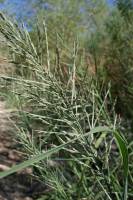Culms (15)25-110 cm, more or less erect, often branching from the aerial nodes. Blades usually densely scabrous on both surfaces, not exceeding the panicle. Panicles 10-57 cm long, (0.5)3-18 cm wide, often ellipsoidal, usually completely exserted from the uppermost leaf sheaths; branches 2-11 cm, mostly ascending. Spikelets 5-10 mm. Lower glumes 1-2.6 mm, narrowly triangular to ovate; upper glumes 1.8-2.8 mm, obovate to widely obovate; lemmas 2-3.6 mm, light brown, dark green, or lead-colored, usually without a basal dark spot, apices usually truncate or obtuse, rarely broadly acute, sometimes bifid, sometimes mucronate; anthers 3, 0.2-0.6(1) mm. Caryopses 1-1.5 mm.
Leptochloa fusca subsp. uninervia is native from the southern United States to Argentina. It may be confused with L. scabra, from which it usually differs in its truncate or obtuse lemmas.
Culms simple or branched from the base, 3-10 dm; sheaths usually overlapping, sparsely papillose-pilose; ligule 1-2 mm, fimbriate-ciliate; blades soft, flat, scabrous on the margins, the larger ones 6-10 mm wide; panicle 1-5 dm, with numerous spreading racemes 5-15 cm; spikelets 1-2.5 mm, 2-4-fld; glumes subulate or narrowly lanceolate, subequal or the second a little longer and broader, sometimes equaling or surpassing the uppermost lemma; lemmas subacute to obtuse or broadly rounded, 0.7-1.5 mm, puberulent on the veins toward the base; anthers 0.1-0.3 mm; grain 0.6-1 mm; 2n=20. A weed of gardens and fields, especially in moist soil; trop Amer., n. to Va., s. Ind., s. Ill., and S.D. (L. attenuata)
Gleason, Henry A. & Cronquist, Arthur J. 1991. Manual of vascular plants of northeastern United States and adjacent Canada. lxxv + 910 pp.
©The New York Botanical Garden. All rights reserved. Used by permission.





